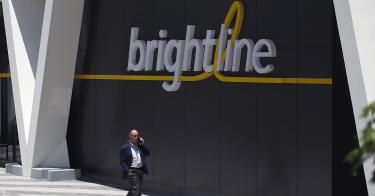On December 8, the federal government made two seemingly disconnected but inexorably linked announcements that do not bode well for America's future.
First, the Department of Transportation hyped an $8.2 billion grant for passenger rail projects.
Second, the Congressional Budget Office revealed that the federal government racked up a $383 billion deficit in just the first two months of FY 2024, with interest payments increasing by a shocking 65 percent year-over-year.
Washington's continued refusal to rein in wasteful and unnecessary deficit spending has led to an unfocused, unaccountable, and increasingly unaffordable federal government that threatens to derail the economy.
To see why, start with the rail money—the bulk of which will go to California.
>>> The Great Train Robbery: Taxpayer Subsidies for Amtrak Should Be Derailed
The state's High-Speed Rail Authority will receive $3.1 billion to continue its singularly awful 520-mile boondoggle from San Francisco to Los Angeles. Following its initial approval in a 2008 referendum, the project has racked up an impressive list of failures over the course of 15 years, including an increase in the estimated cost from $33 billion to over $128 billion; a delay in the estimated completion date from 2020 to at least 2033; and a 2022 New York Times expose revealing many details of California's staggering incompetence and overregulation.
While the project has been beset with then-unforeseen problems, it was primarily undermined by fundamental flaws that should have doomed it from the beginning.
"Should have" because unfortunately both California and the federal government refuse to let this boondoggle die. Even with Washington's latest $3.1 billion injection, the project needs an additional $7 billion just to complete its initial 117-mile segment from Merced to Bakersfield.
Each additional dollar spent makes the project increasingly resistant to criticism or elimination, as the sunk-cost fallacy ensures that politicians will feel obligated to see it through to the bitter end.
The Biden administration is also gambling $3 billion on a high-speed rail line connecting Los Angeles and Las Vegas, spearheaded by the Brightline corporation.
Brightline, known for its privately funded service in Florida, recently opened its high-speed line from Miami to Orlando. The project's relatively smooth construction and more reasonable cost put it in strong contrast with the ongoing debacle in California, as Reason's Natalie Dowzicky explained in September.
However, success in Florida does not guarantee a similar outcome for the L.A.-to-Vegas venture.
Mountainous western terrain alone will add complexity and costs not seen in the Sunshine State. Add in mountainous bureaucratic and legal burdens from California's Environmental Quality Act, along with assorted cost-increasing mandates that come from accepting federal funding, and Brightline's plans could go up in smoke.
The Biden administration's total $8.2 billion rail "investment" flows from the 2021 infrastructure package, which was riddled with budget gimmicks and slush funds from the start and looks even worse with the administration's implementation.
The infrastructure bill was part of an unprecedented $7.5 trillion spending spree from 2020 to 2022. This deficit-fueled bender was a key factor behind the ongoing surge of inflation and, in turn, can be blamed for the recent interest rate spike.
>>> U.S. Credit Gets Downgraded As Signs of Default Become Clearer
Every dollar wasted on political pork, fraud, and poorly considered infrastructure makes the country's fiscal situation even worse.
America's $33.8 trillion gross national debt is the result of Washington's failure to properly budget and prioritize federal activity over the course of decades, although half of the total has been added since October 2013.
The Congressional Budget Office report helps to underline the near-term severity of the problem. Due to the interest rate jump, net federal interest payments rose 65 percent in October and November compared to the year before. Interest payments could eclipse defense spending as early as this year and help drive deficits to unsustainable levels.
Coupled with over $75 trillion in unfunded liabilities for Social Security and Medicare, the federal government's finances pose a tremendous threat to the country's economic prospects.
One small step in the right direction would be for Washington to stop bilking taxpayers for the sake of rail projects that might never be completed, let alone come close to being worth the cost.
This piece originally appeared in Reason.com



